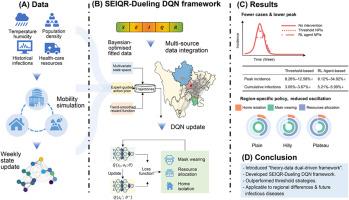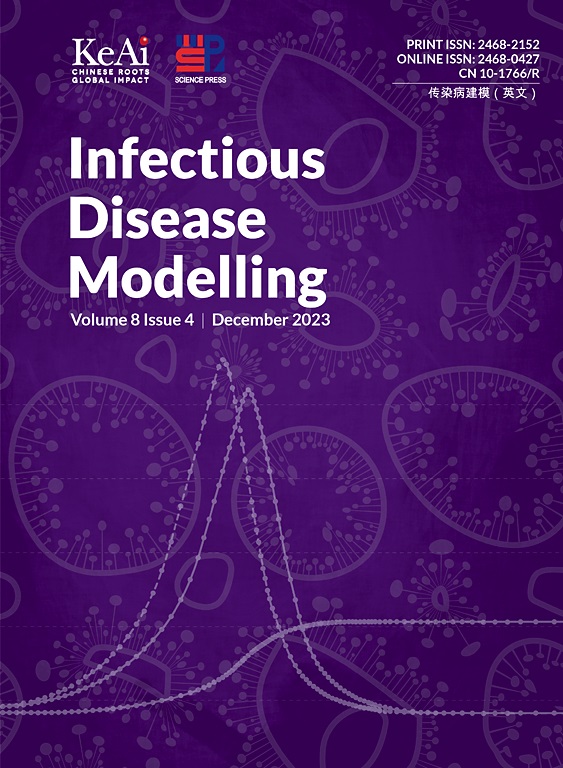优化流感的时空非药物干预:区域异质性的适应性强化学习方法
IF 2.5
3区 医学
Q1 Medicine
引用次数: 0
摘要
流感由于其高传播性、广泛传播和相当大的社会影响,仍然是一项重大的全球公共卫生挑战。传统的基于阈值的非药物干预措施(npi)为疫情控制提供了有价值的框架;然而,这些标准化的方法可能不能完全解释重要的区域异质性。衡量区域特征并准确平衡感染控制和社会经济成本仍然很困难。方法针对平原、丘陵和高原城市,提出了一种易感-暴露-感染-隔离-去除的分区模型-决斗深度q -网络(seiqr -决斗DQN)框架。通过整合气候、人口和卫生保健资源数据,该模型捕捉到了传播和恢复动态方面的区域差异。多维状态空间和离散干预集允许在不同的流行病和资源条件下自适应优化NPI策略。采用序列贝叶斯优化方法估计模型参数,采用自举重采样方法量化不确定性。此外,将SEIQR-Dueling DQN策略与基于阈值的策略在减少累积感染、峰值流行率和干预期长度方面的表现进行了比较。结果基于阈值的干预政策使累计感染率降低3.05% ~ 3.67%,峰值发病率降低8.26% ~ 12.58%,但对区域差异的响应性有限,往往导致控制不足或控制过度。SEIQR-Dueling DQN框架根据当地人口结构和流行趋势动态调整干预时间和组合,平原、丘陵和高原城市的累计感染率分别降低了5.87%、5.99%和5.21%,在平衡考虑社会经济影响的情况下,峰值感染率分别降低了34.92%、22.23%和8.12%。为了评估通用性,将训练好的模型应用于具有不同传输动态的城市,并在不同设置中证明了一致的性能。SEIQR-Dueling DQN框架支持跨地区的量身定制干预措施,并有望在区域异质性和未来新发传染病管理中得到更广泛的应用。本文章由计算机程序翻译,如有差异,请以英文原文为准。

Optimizing spatiotemporal nonpharmaceutical interventions for influenza: An adaptive reinforcement learning approach for regional heterogeneity
Background
Influenza remains a significant global public health challenge because of its high transmissibility, widespread circulation, and considerable societal impact. Conventional threshold-based nonpharmaceutical interventions (NPIs) provide valuable frameworks for outbreak control; however, these standardized approaches may not fully account for important regional heterogeneity. It remains difficult to weigh regional characteristics and accurately balance infection control and socioeconomic costs.
Methods
We propose a susceptible-exposed-infectious-quarantined-removed compartmental model-dueling deep Q-network (SEIQR-Dueling DQN) framework tailored to plains, hilly, and plateau cities. By integrating climatic, demographic, and health care resource data, the model captures regional differences in transmission and recovery dynamics. A multidimensional state space and discrete intervention set allow for the adaptive optimization of NPI strategies across varying epidemic and resource conditions. Model parameters were estimated by sequential Bayesian optimization, and bootstrap resampling was used to quantify uncertainty. In addition, the performance of the SEIQR-Dueling DQN strategy was compared with that of the threshold-based strategy in terms of the reduction in cumulative infections, peak prevalence and length of intervention periods.
Results
The threshold-based intervention policy reduced cumulative infections by 3.05 %–3.67 % and peak incidence by 8.26 %–12.58 % but showed limited responsiveness to regional variation, often resulting in either under- or over-control. The SEIQR-Dueling DQN framework dynamically adjusted intervention timing and combinations on the basis of local demographic structures and epidemic trends and reduced cumulative infections by 5.87 %, 5.99 %, and 5.21 % in plains, hilly, and plateau cities, respectively, while achieving peak reductions of 34.92 %, 22.23 %, and 8.12 %, respectively, with a balanced consideration of socioeconomic impact. To assess generalizability, the trained model was applied to cities with differing transmission dynamics and demonstrated consistent performance across settings.
Conclusion
The SEIQR-Dueling DQN framework supports tailored interventions across regions and shows promise for broader application in the management of regional heterogeneity and future emerging infectious diseases.
求助全文
通过发布文献求助,成功后即可免费获取论文全文。
去求助
来源期刊

Infectious Disease Modelling
Mathematics-Applied Mathematics
CiteScore
17.00
自引率
3.40%
发文量
73
审稿时长
17 weeks
期刊介绍:
Infectious Disease Modelling is an open access journal that undergoes peer-review. Its main objective is to facilitate research that combines mathematical modelling, retrieval and analysis of infection disease data, and public health decision support. The journal actively encourages original research that improves this interface, as well as review articles that highlight innovative methodologies relevant to data collection, informatics, and policy making in the field of public health.
 求助内容:
求助内容: 应助结果提醒方式:
应助结果提醒方式:


